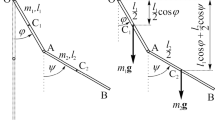Abstract
We consider the low energy dynamics of the double pendulum. Low energy implies energies close to the critical value required to make the outer pendulum rotate. All the known interesting results for the double pendulum are at high energies, that is, energies higher than that required to make both pendulums rotate. We show that interesting behavior can occur at low energies as well by which we mean energies just sufficient to make the outer pendulum rotate. A harmonic balance and the Lindstedt–Poincare analysis at the low energies establish that at small, but finite amplitude; the two normal modes behave differently. While the frequency of the “in-phase” mode is almost unchanged with increasing amplitude, the frequency of the “out-of-phase” mode drops sharply. Numerical analysis verifies this analytic result and since the perturbation theory indicates a mode softening for the out-of-phase mode at a critical amplitude, we did a careful numerical analysis of the low energy region just above the threshold for onset of rotation for the outlying pendulum. We find chaotic behavior, but the chaos is a strong function of the initial condition.


















Similar content being viewed by others
References
Shinbrot, T., Grebogi, C., Wisdom, J., Yorke, J.A.: Chaos in a double pendulum. Am. J. Phys. 60, 491–499 (1992)
Bender, C.M., Feinberg, J., Hook, D.W., Weir, D.J.: Chaotic systems in a complex phase space. Pramana—J. Phys. 73, 453–470 (2009)
Sartorelli, J.C., Lacarbonara, J.: Parametric resonances in a base-excited double pendulum. Nonlinear Dyn. 69, 1679–1692 (2012)
Liang, Y., Feeny, B.F.: Parametric identification of a chaotic base-excited double pendulum experiment. Nonlinear Dyn. 52, 181–197 (2008)
Stachowiak, T., Okada, T.: A numerical analysis of chaos in the double pendulum. Chaos Solitons Fractals 29, 417–422 (2006)
Cross, R.: A double pendulum swing experiment: in search of a better bat. Am. J. Phys. 73, 330–339 (2005)
Cross, R.: A double pendulum model of tennis strokes. Am. J. Phys. 79, 470–476 (2011)
Jordan, D.W., Smith, P.: Nonlinear Ordinary Differential Equations: An Introduction for Scientists and Engineers. Oxford University Press, Oxford (1977)
Landau, L.D., Lifshitz, E.M.: Mechanics. Pergamon Press, Oxford (1960)
Rand, R.: Lecture notes on nonlinear vibration, version 53, pp. 72–76. (2012). eCommons@Cornell. http://hdl.handle.net/1813/28989
Chen, Y.M., Liu, J.K.: A new method based on the harmonic balance method for nonlinear oscillators. Phys. Lett. A 368, 371–378 (2007)
Chen, Y.M., Liu, J.K.: Elliptic harmonic balance method for two degree-of-freedom self-excited oscillators. Commun. Nonlinear Sci. Numer. Simul. 14, 916–922 (2009)
Szemplinska-Stupnicka, W.: The generalized harmonic balance method for determining the combination resonance in the parametric dynamic systems. J. Sound Vib. 58, 347–361 (1978)
Hatwal, H., Mallik, A.K., Ghosh, A.: Forced nonlinear oscillations of an autoparametric system—part 1: periodic responses. J. Appl. Mech. 50, 657–662 (1983)
Hatwal, H., Mallik, A.K., Ghosh, A.: Forced nonlinear oscillations of an autoparametric system—part 2: chaotic responses. J. Appl. Mech. 50, 663–668 (1983)
Vakakis, A.F., Rand, R.: Normal modes and global dynamics of a two-degree-of-freedom non-linear system—I. Low energies. Int. J. Non-Linear Mech. 27, 861–874 (1992)
Vakakis, A.F., Rand, R.: Normal modes and global dynamics of a two-degree-of-freedom non-linear system—II. High energies. Int. J. Non-Linear Mech. 27, 875–888 (1992)
Chen, S.H., Cheung, Y.K.: A modified Lindstedt–Poincare method for a strongly non-linear two degree-of-freedom system. J. Sound Vib. 193, 751–762 (1996)
Antia, H.M.: Numerical Methods for Scientists and Engineers. Tata McGraw-Hill, New Delhi (1995)
Acknowledgements
Jyotirmoy Roy was supported by the National Initiative on Undergraduate Science (NIUS) undertaken by the Homi Bhaba Centre for Science Education—Tata Institute of Fundamental Research (HBCSE-TIFR), Mumbai, India.
Author information
Authors and Affiliations
Corresponding author
Rights and permissions
About this article
Cite this article
Roy, J., Mallik, A.K. & Bhattacharjee, J.K. Role of initial conditions in the dynamics of a double pendulum at low energies. Nonlinear Dyn 73, 993–1004 (2013). https://doi.org/10.1007/s11071-013-0848-1
Received:
Accepted:
Published:
Issue Date:
DOI: https://doi.org/10.1007/s11071-013-0848-1




